A Wrighteous Wretrospective--The Legend of Zelda: Majora's Mask
By wrighteous86 20 Comments
"A Wrighteous Wretrospective" is an ongoing series where we look back at games from the past and analyze where they came from, how well they've held up since release, and what the future holds for the game and its ongoing legacy. Today, we'll be taking a look at...
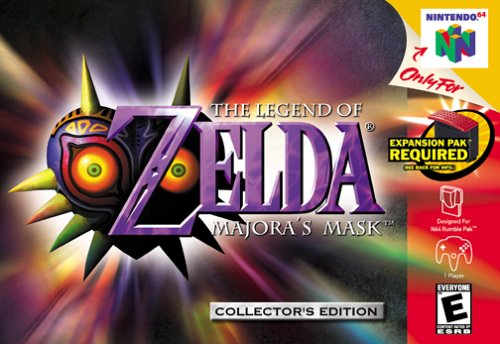
You're pretty good at this. Have you done this before?
When Nintendo announced the Nintendo 64DD add-on for the Nintendo 64 in 1995, they stated their intent that The Legend of Zelda: Ocarina of Time would be one of the premier titles for the accessory--a game of such scale that it would only be possible with the additional power provided by the disk drive. Part of their plan for the game included releasing content updates for Ocarina that included remixed dungeons--which eventually became Ocarina of Time: Master Quest--and an expansion to the game that reused assets in a whole new environment and storyline. After the 64DD became a commercial failure and Ocarina was scaled back in ambition and technology to fit onto a N64 cartridge, the "side story" concept would go on to become a full-fledged game of its own, The Legend of Zelda: Majora's Mask, in 2000.
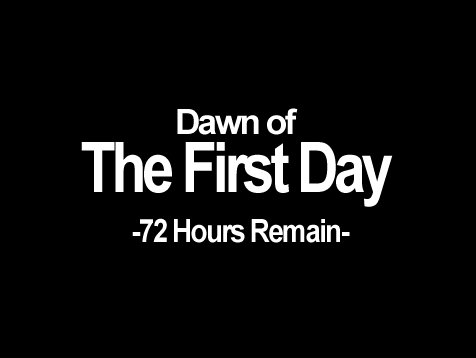
Following the dramatic success of Ocarina of Time was an interesting prospect for Nintendo. They wanted to take advantage of the game's recent popularity while also experimenting with the series. Shigeru Miyamoto, the series creator, was also interested in developing new games and intellectual properties, so he decided to hand off development of the Ocarina follow-up to a developer on that title, Eiji Aonuma, who would go on to become the director of the series going forward. The idea was that a side-story utilizing the same audio and visual assets as Ocarina could be completed in a shorter time-frame and would allow for more creativity and an emphasis on new ideas and gameplay for the series. It would provide a decent test-bed for the newly appointed director to make his mark on the series while also capitalizing on a gaming market hungry for more Zelda. Miyamoto and Yoshiaki Koizumi were credited with coming up with the basis of the storyline and the "three-day system" that the game would revolve around, and then handed the game off to its new team.
Majora's Mask is a direct sequel to Ocarina of Time--such continuity being a rarity in the series--that tells the story of Link leaving Hyrule in search of Navi, with whom he'd parted ways after his adventures through time. When a familiar Skull Kid wearing a mysterious mask and two mischievous fairies ambush Link in the middle of the Lost Woods and steal the Ocarina of Time and Epona, Link follows them through a strange tree and finds himself transformed into a Deku Scrub and lost in a strange new world that seems oddly familiar. This parallel universe, named Termina, is a twisted reflection of Hyrule, where the people he meet look similar to old friends but lead very different lives. Link makes a deal with the Happy Mask Salesman from Ocarina that will restore him to his true form in return for getting back his stolen belongings and collecting Majora's Mask: a mask containing an evil god that the Skull Kid had taken from the salesman earlier on. Link travels into this new world seeking revenge and looking to right the wrongs the Skull Kid has done to the many people in the market town and the lands surrounding it--including preventing a malevolent moon hanging overhead from crashing into the earth in three-days time and killing everyone. Link must relive these three days over and over again searching for new items, abilities, and information that will help him prevent the end of the world and get back to Hyrule.
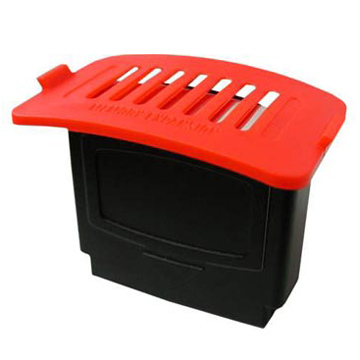
As Majora's Mask was originally conceived for the 64DD, work on the game had taken advantage of the increased power the console add-on provided and utilized an upgraded version of the Ocarina of Time engine. As such, when Nintendo decided to abandon the disk drive and move the game over to N64 cartridge development, they were faced with the choice of abandoning the work done on the game and starting from scratch or supporting some other form of increased power. The game was one of a few N64 games to require the 4MB Expansion Pak for the N64 to play on the system--the extra RAM enabled Majora to increase the resolution and draw distance when compared to Ocarina and allowed for more characters on-screen at one time, all of which were necessary given the emphasis on towns and the three-day repeating cycle that the game was designed around. The increased memory allowed the console to keep track of the real-time schedules of the non-player characters in the game world and remember which actions Link had or had not taken during any given three-day cycle as well as allowing for real-time graphics as opposed to the pre-rendered backgrounds from Ocarina.
72 hours, 24 masks and just one moon.
The main concept behind Majora's Mask is the three-day cycle--every event in the game takes place over the course of the same three days. Each hour roughly translates to about a minute of game time, so the cycle must be restarted every hour. However, very early in the game, Link finds a way to work around this time limit with his ocarina: Link can slow down the flow of time by about three times, he can skip forward to dawn or dusk of the current day, and he can warp to owl statues littered across Termina to appear instantaneously in another area. Using these techniques, the time limit becomes much less restrictive with a little bit of planning. Tackling a Zelda dungeon in under three hours isn't all that difficult, and you can get a surprising amount of overworld quests done in the same amount of time.
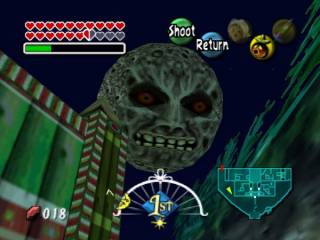
The three-day cycle is done to great effect and places a heavy importance on everything the player does in Termina. The clock is constantly at the bottom of the screen, ticking down to the end of the world. As time passes and destruction nears, the game's music begins to get faster and more frantic, played in a darker and more sinister key. On the Final Day, the earth trembles at random and the sky turns an eery shade of green. In the final moments, the game clock becomes a flip clock, counting down the seconds until the moon crashes. While all of this lends an oppressive atmosphere to the game as a constant reminder of what's at stake, it can make the game feel pretty stressful. It's like an hour-long version of the Sonic the Hedgehog drowning music or the manic "time's running out" theme from Super Mario Bros. Add to that the fact that the save system requires players to either record their progress at an owl statue without the ability to reload or to do a traditional save by restarting the three days, and there's a lot of pressure to make the most of one's time. This is probably the reason many people gave up on the game before reaching the first dungeon--they didn't realize that they were about to receive methods to alter the flow of time that would ease back on the intensity of the game. Still, the tone might be bleaker than what some are looking for in a Zelda adventure, so it's reasonable that so many Ocarina fans were disappointed in Majora's Mask.
Another major gameplay conceit in Majora's Mask is, appropriately enough, masks. Unlike the mask-trading side quest in Ocarina, Termina's masks often provide Link with a unique ability, like the Mask of Scents which allows Link to "see" smells--a skill he'd later have in wolf form for Twilight Princess--or the Blast Mask which allows Link to explode once every 20 seconds, at the expense of some of his health. The most important masks, though, are the three main transformation masks that allow Link to transform into a Deku Scrub, a Goron, or a Zora--each with their own animations, instruments, sound bites, and attack styles. The Deku Scrub can hop across the surface of a body of water and shoot bubbles out of its mouth like a slingshot, Goron Link can roll up into a ball to travel at high speeds and is immune to lava, and Zora Link can move freely in the water and shoot his fins out like two boomerangs. Each transformation also triggers different responses from NPCs--most people will treat the Deku like a child, are intimidated by the Goron, and are in awe of the Zora, while each respective race is more responsive to one of their own. It's really impressive how deep the characters can be just by following them through their days, but even more impressive once you realize that you can get multiple responses from some of them based on your appearance.
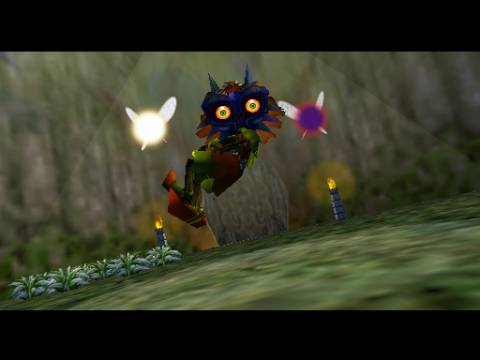
Exploration still plays a key role in the game, but it involves exploring the lives of characters rather than examining the nuances of the environment. Link goes through the same three days over and over again and gets to know the events in the lives of the townspeople intricately, much like the Bill Murray comedy, Groundhog Day. It's really fun following a character around for three days and seeing how their lives have been thrown into disarray by the Skull Kid, how they relate to their neighbors, and how they react to the knowledge that their world could very well end in the next few days. Some face their fates bravely, some resort to desperate measures, others just want one last moment of happiness before they accept their own death, and Link, the only one able to rewrite history, is their only hope. It's an oddly satisfying feeling walking through Termina late in the game and watching the NPCs go about their lives around you, knowing what the future holds for them. "Oh, there goes the circus leader. In a minute he'll find out that his show has been cancelled which will depress him enough to patronize the town's milk bar, annoying the bar's owner who is worried that they haven't been getting their shipments lately, before arguing with a band manager whose lead singer is missing her voice." It gives the player a strange sense of omniscience, and it's fulfilling knowing how to fix all of their problems.
It's fulfilling, that is, until you reset the three-day cycle and all the good you've done for these people is forgotten and erased. It's rewarding to help a person solve their dilemmas and receive a reward, but since some character plot-lines are intertwined, results don't carry over when the three days begin again. If one person's problem is already solved, then he or she wouldn't go through their three days in the same manner, and thus wouldn't be in the right location or the right mood to kick-start a portion of someone else's story. Even though, according to the plot, the changes you make do wind up ultimately occurring, over the course of the game the player is only allowed to enjoy the fruits of their labor until they play the Song of Time and reset events. This is also a problem when completing dungeons. Freeing each area's guardian giant from the Skull Kid's evil masks fixes the problems with that area. Termina's Southern Swamp, for example, has been poisoned and the Deku princess kidnapped. Upon completing the dungeon, the princess is returned and the swamp waters are cleansed and open up new pathways and ease travel in that area--but again, your success is only temporary, and to re-experience this reward, a player would have to re-enter the dungeon and defeat the boss again, although, the puzzles and doors would remain solved; there is the option to face the boss upon immediately entering a completed dungeon.
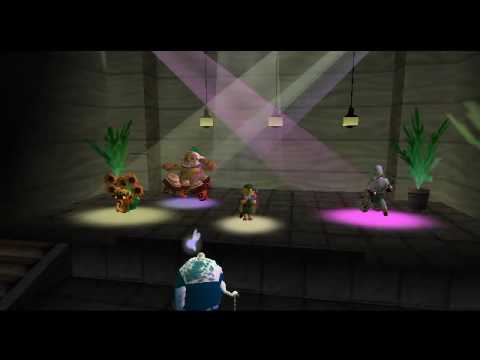
Side quests also tend to emphasize character interaction. In this sense, the game has a lot in common with adventure games. Many of the side quests involve finding the right item and giving it to the right person at the right time after following them and seeing what they need to complete their goals before the moon drops. Many of the people need help multiple times over the course of three days and their lives affect other townsfolk, the most notable of which involves helping an engaged couple reunite before the world ends. Some of the NPC-quests are more traditionally skill-based, but even these put you in pretty unique situations for the series; at different points in the game, Link is tasked with performing as the house band of a milk bar, preventing cattle from being abducted by aliens, and stopping the mugging of an old woman late at night. You'll still solve environmental puzzles, traverse dungeons, and battle bosses, but Majora's Mask puts decidedly more emphasis on the adventure aspects of the action-adventure genre. Whereas most Zelda games are about 10%-20% plot and character focused, Majora's Mask is probably an even split: 50/50.
The traditional Zelda gameplay is still in there, though. The game has four main dungeons, a number of mini-dungeons, and some of the more creative and difficult bosses the series has had in a long time. One boss is a giant mechanical goat that runs around a ring shaped arena, and Link has to chase him down in ball form as a Goron and take out his legs to attack him. Another boss has Link growing to giant size to take them down amid (relatively) tiny pyramids and obelisks. A few of the dungeons require some deep thought when trying to get from place-to-place, much like the City in the Sky from Twilight Princess or the infamous Water Temple from Ocarina of Time. The fourth dungeon, however, is the Stone Tower, and is irritating for many of the same reasons that the aforementioned Water Temple is. Many of the puzzles in that section of the game require Link to play a long song on his ocarina and switch transformation masks multiple times to make any progress. Going in and out of the menu just adds to the tedium of that temple, which is otherwise pretty interesting for its gravity-flipping puzzle mechanics.
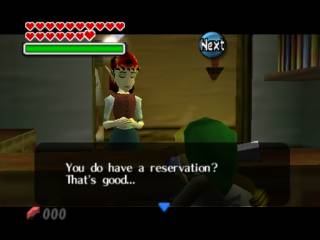
While the three-day cycle allowed Nintendo to try new gameplay ideas and plot concepts, it wasn't perfect. As one could probably assume, forcing Link to repeat the same three days constantly can get a bit... repetitive. There are many instances in the game where the player will know exactly what they have to do, but they're stuck waiting for the right person to show up or for the right shop to open. Even if the longest wait is five minutes for a location to open or a cutscene to trigger, that's still five minutes where the player is not involved in the game and it really kills the pacing of the adventure. Gamers will also come across instances where they'll show up seconds late to deliver an item or escort a character, and must start the entire quest over again from the beginning. Most of the clues towards what a character needs or what abilities are required to complete a quest are really subtle, or require objects that may not have been obtained yet, which makes the time spent on them a wasted opportunity to advance in the game. The emphasis on these side storylines serve to draw the game out, though, and most people will probably lose their drive by the time they hit the last of the four dungeons. The endgame is ultimately worth it, and really satisfying, but the game is just a bit too slow in leading up to it.
There are plenty of rewards for gamers that seek to complete everything that the game has to offer, which is refreshing compared to other games in the series. Majora's Mask is one of the best Zelda games in terms of "bonus items" that are not required to complete the game. In addition to the usual hearts and the abundant masks, thorough players can also gain access to three different upgraded swords, up to six bottles, more health and magic, stronger offensive and defensive abilities, and most importantly, the Fierce Deity Mask which is rewarded for collecting every other mask in the game. The Fierce Deity Mask is usable only during boss battles and transforms Link into a white-garbed god, three-times his normal size, with a large and powerful sword that shoots energy projectiles at long distances--a throwback to the projectile swords and the white tunic from the 2D Zelda games. It's the ultimate form of fan service that allows Link to take down the game's difficult bosses in a matter of seconds.

Technically, the game is dated, but holds up fairly well. It improves on Ocarina pretty successfully in some key areas: the image is crisper, the color is brighter, and there's more on-screen at any given time when compared to its predecessor. Despite the increased RAM from the Expansion Pak, though, the game still suffers from slow-down during some of the more complicated boss fights, which is disappointing. The graphics are still blocky and dated, but the animations are pretty impressive, considering when the game was released, and they really sell some of the jokes, personalities, and plot-points in the game. The lack of direct camera control is still a significant problem that lock-on targeting only partially solves. Epona's controls have been refined somewhat, and she's less finicky, although she still steers a bit like a tank. The ability to skip and speed up text is very welcome, but practically a necessity, since you'll be getting repeat dialog every time you restart the three-day cycle. Majora reuses and remixes some of the more famous themes from Ocarina, but manages to add some classic songs of its own. Also of note is the return of the main Zelda theme song to the overworld, which was oddly and notably absent from Ocarina of Time.
The annoying Navi character has been replaced with Tatl, who offers her advice much less often and does so with a jingling bell noise, rather than the ever-infuriating, "Hey! Listen!" She has more of a personality when she does talk, too, being more sarcastic and dismissive then the usually milquetoast Navi and providing a surrogate "voice" for Link in important scenes. Kaepora Gaebora shows up in the game only twice, and is much less long-winded than he was in Ocarina of Time. It seems like Nintendo was listening to these complaints when they began work on this follow-up. One of the main additions to the Zelda cast in Majora, however, is the mostly reviled Tingle--a 35-year-old man who dresses in a green spandex body suit, dreams of having a fairy, and floats through the air with a backpack-concealed balloon. While the character is still as disturbingly odd and irritating in Majora's Mask as he'd later become known for, his character at least makes sense in this game, as he's a resident of Termina, Hyrule's own twisted version of Wonderland where plants will scatter in fear if you cut one of their number down. You only interact with Tingle a handful of times to buy maps for each of the games overworld locations, and aside from that, he's relatively unobtrusive. At the time, fan reactions in the United States were unkind, which makes it even odder that Nintendo utilized him so often in the series going forward. Hell, he even eventually got his own game in certain regions! He's easily ignored though, and has little effect on the quality of Majora's Mask.
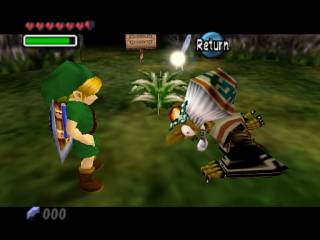
In the end, due to the oppressive tone, the amount of time spent with the characters, and the complex plot, Majora's Mask tends to have one of the more unique and interesting stories in the Zelda series. While it's technically similar to Ocarina of Time, the game is functionally very different, with its slower and more deliberate pace and its emphasis on relationships and plot over action and dungeons. It takes familiar items, characters, and themes from Ocarina and inverts them, allowing for a game that's simultaneously familiar and radical for the series.
The world is waiting on you.
While Majora's Mask isn't remembered as often or as fondly by gamers as other installments in the series, it has left its mark on gaming in smaller, more subtle ways. The transformations that Link could undergo allowed Nintendo to flesh out the races of Hyrule in ways players hadn't seen before, by allowing them to physically control them during the course of the adventure and experience how others treated each race respectively. This would later become an important aspect of Twilight Princess, which adopted many of the transformation abilities for Link's wolf form in that game.
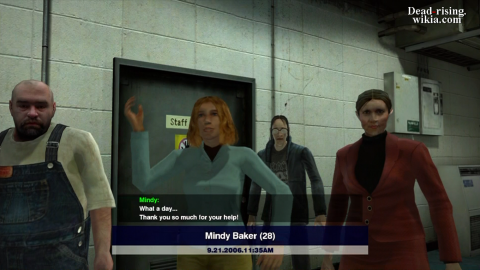
Similarly, fans of the schedule and time mechanics in Majora's Mask will likely find something to love in the Dead Rising series. The Dead Rising games abandon the repeating three-day cycle but have a comparable schedule system that requires gamers to find and interact with characters in certain locations at specific times over the course of the game and a real-time clock that counts down to a deadline for the end of the game. Much like in Majora's Mask, players are fighting against time as much as they are against the game's enemies, and they must effectively plan ahead to make sure that they allot enough room to accomplish the goals in their time-sensitive schedules and successfully interact with the game's characters. The Dead Rising series even adopted the concept that you could only save your progress in two distinct ways--as a one time save that couldn't be reloaded via the bathroom stalls, or by restarting the game but saving the character's personal progress. These games surprisingly have a lot in common, in those respects.
Dragon Age II found itself in a similar situation to Majora's Mask, recently. Both games were follow-ups to more successful games that were released less than 2 years earlier. Both games chose to focus the main plot on a specific town and its surrounding areas, but aside from that, they took very different approaches. Unlike Majora's Mask, the Dragon Age team decided to abandon the assets of their predecessor and overhaul the gameplay. Nintendo, conversely, carried those aspects of Ocarina of Time over and decided to focus on creating new content that was much deeper and more involved. Bioware had spent more of their time updating their game from Origins, and had less time to focus on the story and characters, which garnered complaints from critics and fans alike. Oddly enough, Origins had an expansion campaign released, called Awakening, that followed the Majora's Mask method more closely, reusing assets and focusing on smaller locations to emphasize high-level play and the continuation of the plot. Ultimately, even Awakening had its flaws, but it makes one wonder that if it was provided some of the man-power and funding that instead went to Dragon Age II that perhaps it would have been the more worthy sequel. If Bioware had learned some of the lessons from Majora's success, both Dragon Age follow-ups might have been better for it.
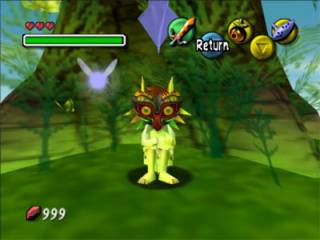
In the end, Majora's Mask was received to rave critical reviews but went on to sell just under half as many copies as Ocarina of Time. The game was praised for its improved graphics, deeper storyline, and darker tone which implied that Nintendo had avoided taking the "easy way out" with their quick sequel to "the best game of all time". At the same time, the game was criticized for being alienating to the core Zelda fan-base, being too radically different from what many expected a Zelda game to be and much less accessible to the average gamer. Critics claimed that the mini-games and side quests could easily cause the game to feel tedious, but that gamers who persevered would be rewarded with a deeper story and more interesting characters. Along with Zelda II: The Adventure of Link, Majora's Mask is considered a "dark horse" in the Zelda franchise, which also chose to take a familiar concept in a new direction instead of going with the status quo immediately following a more popular and accessible landmark title. It was one of the key games in the franchise to attempt something more than collecting items and fighting Ganon to save Zelda and the Triforce. It tried something new and is special for it. Like Link's Awakening before it, Majora's Mask takes some bold strides forward into less explored aspects of the series, and for that reason, it tends to be an incredibly divisive game to this day.
That's all for today. I hope you enjoyed this Wretrospective, and maybe learned a little something in the process. Feel free to post comments, opinions, and memories of this game below. Thanks for reading!
For more Wretrospectives, follow the links below:
